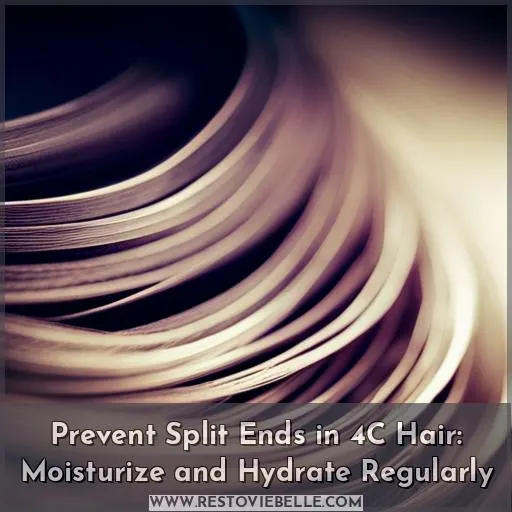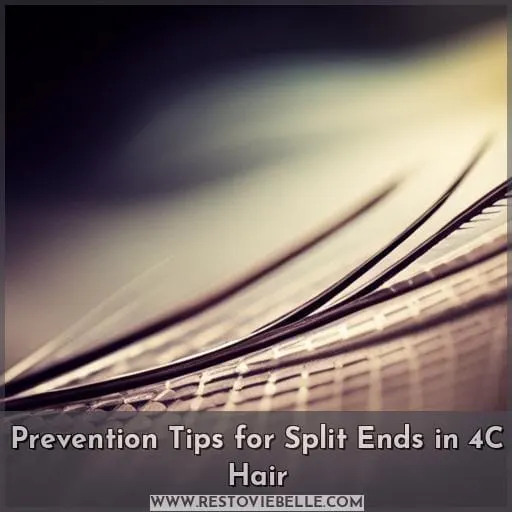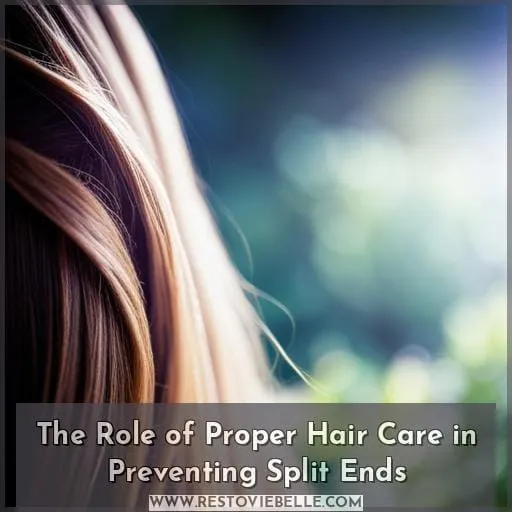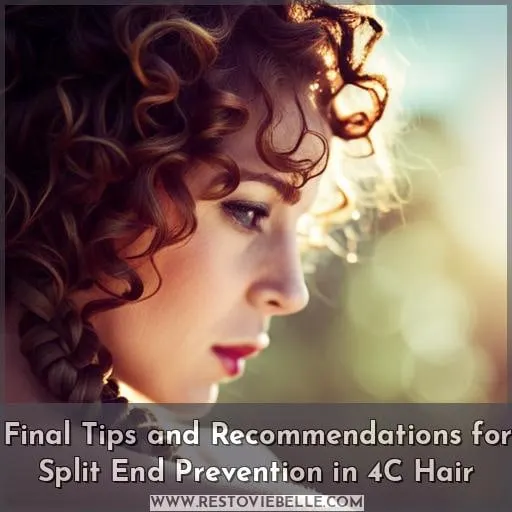This site is supported by our readers. We may earn a commission, at no cost to you, if you purchase through links.
 Gorgeous, thick, and luxurious 4C hair can be a beautiful sight when it’s well taken care of. However, split ends are one of the most common problems for people with this type of hair. They’re caused by improper care techniques such as excessive heat styling or washing too often.
Gorgeous, thick, and luxurious 4C hair can be a beautiful sight when it’s well taken care of. However, split ends are one of the most common problems for people with this type of hair. They’re caused by improper care techniques such as excessive heat styling or washing too often.
Table Of Contents
- Key Takeaways
- Understanding Split Ends in 4C Hair
- Prevention Tips for Split Ends in 4C Hair
- Identifying and Treating Split Ends in 4C Hair
- The Role of Proper Hair Care in Preventing Split Ends
- Recommended Products for Split End Repair in 4C Hair
- How to Use the Eden BodyWorks Almond Marshmallow Trio for Split End Repair
- Final Tips and Recommendations for Split End Prevention in 4C Hair
- Conclusion
Key Takeaways
- Split ends occur when the hair shaft frays and splits.
- 4C hair is prone to split ends due to its tight curl pattern.
- Regular trimming every 3 months is essential for prevention.
- Preventing split ends requires reducing heat exposure, regular moisturizing, using deep conditioners, protective styling, and gentle detangling.
Understanding Split Ends in 4C Hair
Split ends, also known as trichoptilosis, occur when the hair shaft frays and splits due to various external influences such as heat exposure, coloring, or environmental factors. The tendency for split ends in 4C hair is largely due to its tight curl pattern, which makes it more prone to damage from lack of moisture, heat styling, and brushing.
Definition and Appearance of Split Ends
You gotta keep your curls looking their best, so you better know how to recognize split ends when they come a knockin! Split ends occur at the end or middle of hair strands and are caused by improper care and wear and tear on weak parts.
4C hair is especially vulnerable due to its tight curl pattern. Signs include fraying along the shafts, dryness, dull appearance, and tangles or knots in the middle of a strand.
To prevent split ends, it’s important to reduce manipulation and heat exposure, moisturize regularly, use deep conditioners and leave-in treatments, and trim every 3 months (or DIY). Additionally, seeking out natural remedies like coconut oil can provide added protection and softening effects.
Causes of Split Ends in 4C Hair
Understanding how your 4C hair reacts to environmental factors and treatment is essential in avoiding split ends. Heat damage, moisture balance, porosity levels, and protective styles are all key elements that can affect the health of your locks.
Split end types ranging from single strand knots to fraying shafts need extra attention when trying to prevent them from forming.
Protective styles such as braids or buns allow for less manipulation, which reduces wear-and-tear on weak parts of the hair leading up towards split ends. Using silk bonnets at night provides additional protection during sleep time too! With these tips, you’ll have strong, gorgeous curls free from pesky splits in no time.
Prevention Tips for Split Ends in 4C Hair
As a 4C hair type, you may be more prone to split ends due to the tight curl pattern of your hair. To prevent split ends from forming or worsening, it is important that you moisturize and hydrate your strands on a regular basis.
Doing this will help keep your curls healthy and strong while reducing breakage caused by dryness.
Moisturizing and Hydrating the Hair Regularly
To keep your 4c hair healthy and prevent split ends, regular moisturizing and hydrating is key. Deep conditioning with natural oils like shea butter provides intense hydration.
Protective styles can help reduce manipulation of the hair while decreasing exposure to environmental factors that can cause damage or breakage, as well as split ends in 4c hair. Additionally, incorporating a high-quality hydration serum into your haircare routine can effectively lock in moisture without adding weight or causing buildup over time.
Avoiding Heat-styling Tools and Excessive Manipulation
Minimizing heat styling and manipulation can help protect your 4C hair from split ends. Avoiding chemical treatments, using protective styles, gentle detangling, and regular haircuts are essential to maintain its health.
Trimming natural hair regularly will also reduce the chances of split end formation while avoiding heat-free styling keeps it safe in the long run.
Gentle Detangling Techniques to Prevent Breakage
Gently detangle your 4C hair with a wide-tooth comb and natural oil to prevent breakage. Utilize protective styles, moisture retention, and quality products for healthy hair care maintenance. Use less manipulation when styling, minimize heat exposure, and apply gentle techniques like finger detangling or the LOC method (liquid/leave-in conditioner + oil + cream).
Try deep conditioning masks twice a month with nourishing ingredients such as almond butter or avocado; this helps strengthen the strands while promoting hydration.
Regular Trimming to Remove Split Ends
Regularly trimming your ends helps keep them healthy and free from split damage. Split ends are caused by excessive heat styling, chemical treatments, environmental factors, and improper care. Trimming benefits include removing weakened hair strands, which prevents the spread of split ends throughout the head.
To ensure maximum health for 4c hair, use a deep conditioning mask or serum to moisturize. Then, use sharp shears to trim any visible splits when stretching out the curls with your fingers before cutting away damaged sections.
Regular trims will help mitigate further damage. Caring for 4c tresses properly with protective styles is key in keeping these vulnerable locks strong!
Protective Styling to Minimize Damage
To protect your 4C hair from split ends, consider using protective styling such as wigs and extensions. Braiding techniques can reduce manipulation and heat damage. Silk scarves, satin pillowcases, and hair bonnets also prevent breakage at night while sleeping.
Identifying and Treating Split Ends in 4C Hair
It’s important to understand how to identify and treat split ends in 4C hair. Split ends, also known as fraying or splitting of the hair shaft, can occur at the end or middle of a strand due to improper care and wear-and-tear on weak parts.
DIY trimming techniques, such as stretching the hair with sharp shears, are helpful for removing split ends without sacrificing length.
How to Recognize Split Ends in 4C Hair
Check for any fraying at the ends of your 4C hair strands to identify potential split ends.
- Visual Signs – Look for jagged edges or white dots along the shaft of individual hairs as well as a fuzzy appearance.
- Texture Analysis – Use your fingers to feel if there is an abrupt change in texture between healthy and damaged sections.
- Inspection Techniques – Examine with a magnifying glass or use bright light when searching.
- Early Detection – Check often during styling regimens (e.g., blow-drying). By being mindful of your routine, you can detect split ends before further damage occurs and take steps towards prevention!
The key is regular inspections so that proper care can be taken immediately. With diligence and knowledge about how to recognize them, you’ll have beautiful curls always!
DIY Trimming Techniques for Split End Removal
Using sharp hair shears, you can swiftly and delicately snip away split ends like a master sculptor carving intricate details into marble. DIY trimming is an effective way to remove split ends from 4C hair while minimizing further damage.
With the right technique and tools, it’s possible to maintain healthy locks at home without professional help or expensive treatments. Start by stretching out your curls so that individual strands are easier to see before carefully cutting off any damaged bits of hair with scissors held parallel to the scalp in one swift motion.
Afterward, use natural oils like Jojoba or Castor oil, as well as leave-in conditioner, for added moisture retention and protection against future breakage caused by heat styling or environmental stressors such as harsh weather conditions.
Regularly trimming helps keep your mane strong, healthy, and looking its best!
The Role of Proper Hair Care in Preventing Split Ends
It is essential for 4C hair to maintain moisture and use deep conditioning treatments regularly. Utilizing leave-in conditioners, serums, and protective styles helps nourish the hair strands while protecting against environmental damage.
By taking the appropriate steps in caring for your 4C hair, you can help prevent split ends from occurring or worsening.
Importance of Moisture and Deep Conditioning for 4C Hair
Maintaining adequate moisture and regularly deep-conditioning 4C hair is essential for preventing split ends. Increased hydration benefits include improved softness, strength, and shine. To restore healthy curls, it is recommended to do deep conditioning techniques such as hot oil treatments or protein masks every 2 weeks.
For long-lasting results, use moisturizing products like leave-in conditioner or creams with natural oils such as jojoba oil. These products nourish your curls without weighing them down. Additionally, protective styling helps maintain hair health by allowing the scalp to breathe and reducing manipulation of the strands, which can lead to breakage or split ends over time.
Using Leave-in Conditioners and Serums to Nourish the Hair
Nourish your hair with leave-in conditioners and serums, infusing it with a burst of moisture for that healthy shine. Applying the right product is key to keeping split ends away. Consider using natural oils or creams specifically formulated for 4C hair.
For application techniques, start at the tips and work your way up to prevent further damage. Serum benefits include sealing in moisture and providing a protective barrier against heat styling tools.
Consider adding products like Aunt Jackie’s Flaxseed Repair Masque or Cantu Shea Butter Leave-In Conditioner into your routine for maximum nourishment! Finally, remember that protecting the strands by wearing protective styles goes hand in hand with maintaining optimal hydration levels when caring for 4C hair prone to split ends.
Protective Measures Against Environmental Damage
To protect your hair from environmental damage, invest in products like shea butter and silk bonnets. For 4c hair types, weather-related damages such as humidity and wind can cause split ends. Natural oils like jojoba or almond oil are a great way to lock in moisture and provide protection against the elements.
Protective styles also help guard against further breakage by minimizing manipulation of the strands. This is especially helpful during extreme temperatures! Consider investing in quality styling tools that won’t strip away any natural oils present when using heat for styling purposes.
Recommended Products for Split End Repair in 4C Hair
Are you searching for products to repair split ends in 4C hair? Look no further! Trader Joe’s Tea Tree Tingle Shampoo, Aunt Jackie’s Flaxseed Repair Masque, Cantu Shea Butter Leave-in, Viva Naturals Coconut Oil, and Mielle Organics Mongongo Oil Heat Protectant are all excellent choices.
These natural products work together to nourish your hair and ensure that it remains healthy and strong.
Trader Joes Tea Tree Tingle Shampoo
Try Trader Joe’s Tea Tree Tingle Shampoo – certified organic botanicals, no laurel/laureth sulfates. Customers praise it for refreshment, scalp relief, and moisturizing effects on 4C hair. Nourish locks further with sweet almond oil, flaxseed repair masque, and Cantu Shea Butter leave-in conditioner.
Aunt Jackies Flaxseed Repair Masque
Aunt Jackie’s Flaxseed Repair Masque is a natural conditioning cream designed to soften, shine, and moisturize dry 4C hair. It contains flaxseed, mango butter, shea butter, and coconut oil for improved condition, plus Omega Fatty Acids.
Cantu Shea Butter Leave-in
Experience the nourishing power of Cantu Shea Butter Leave-in! A natural and sulfate-free cream, it repairs split ends and defines curls like no other. Unlock your hair’s full potential with its leave-in benefits, styling techniques, and product application for curl definition, all while promoting healthy hair growth.
Viva Naturals Coconut Oil
Viva Naturals Coconut Oil is an all-in-one kitchen and beauty staple for healthy, nourished hair. It’s USDA Certified Organic & Non-GMO Project Verified and perfect for baking, frying, or sautéing.
As a conditioner and detangler, it helps repair split ends in 4c hair while moisturizing skin, leaving it soft and smooth.
Mielle Organics Mongongo Oil Heat Protectant
Mielle Organics Mongongo Oil Heat Protectant protects hair from heat styling tools and provides intense defense for all hair types. This silicone-free serum is great for preventing split ends, adding hydration, defining curls, and moisturizing hair.
It is suitable for weather conditions such as heat exposure or color damage, while also creating soft, frizz-free hair.
How to Use the Eden BodyWorks Almond Marshmallow Trio for Split End Repair
Split ends are a common issue in 4C hair, but with the right products and practices, they can be easily managed. The Eden BodyWorks Almond Marshmallow Trio is an ideal solution for repairing split ends.
Follow the instructions for each product to get optimal results while also remembering to follow preventive tips such as gentle handling of your hair and protective styling.
Instructions for Using Each Product Effectively
To achieve optimal results, use the Eden BodyWorks Almond Marshmallow Trio regularly to help restore and repair your hair’s split ends.
- Apply the product from scalp roots to tips in an outward motion with a wide-tooth comb while detangling.
- Use it as part of your regular weekly hair care routine. Apply it at least once per week before styling or bedtime for best results.
- Place it on dampened sections of 4C curls after shampooing and conditioning. Focus extra attention on the ends where split ends are more likely to occur.
- When styling, avoid manipulating too much, which can lead to further breakage. Use low heat settings when blow-drying or curling/straightening instead!
- Hydrate often with products that contain marshmallow root extract like this one for maximum moisture retention and improved elasticity over time.
With proper application and consistent maintenance of these steps, you’ll be well on your way towards getting rid of those pesky split ends!
Reminder to Follow Prevention Tips in Conjunction With Product Use
Along with using the Eden Bodyworks Almond Marshmallow Trio, remember to practice preventative measures like gentle hair handling, moisture retention, and protective styling for optimal split end repair.
Product effectiveness is increased by maintaining a routine of regular trims and deep conditioning treatments.
To promote growth while also protecting against split ends, try different techniques such as braiding, twisting, or wrapping your hair around rollers before bedtime.
Protective styles are not only an effective way to keep your hair healthy but they can also be used to create unique hairstyles that you can show off!
Moisture retention should always be part of any good 4C Hair care regimen. Natural oils, such as coconut oil, are great for this purpose due to their ability to penetrate the shaft quickly and deeply hydrate from within.
With proper care coupled with Eden’s Split End Repair System, you’ll have beautiful curls all year long!
Final Tips and Recommendations for Split End Prevention in 4C Hair
As a 4C hair type, split ends can be an unavoidable part of your hair journey. However, with regular maintenance and care, you can prevent the occurrence of split ends in the future. Regular trims are essential for maintaining healthy length, while deep conditioning treatments and protective styles provide necessary moisture that will keep your strands strong against heat damage or environmental factors.
Emphasizing the Importance of Regular Maintenance and Care
Regularly caring for and maintaining your 4C hair is essential to preventing split ends. To ensure the health of your locks, establish a regular maintenance routine that works best for you.
- Moisturize regularly with deep conditioning treatments and protective products like shea butter and silk bonnets.
- Trim split ends every three months or as needed.
- Embrace protective styles to limit heat exposure and manipulation.
- Invest in quality products designed specifically for 4C hair types, like EDEN BodyWorks Almond Marshmallow Trio.
With proper care, patience, dedication, and a little love, you can combat the effects of split ends on beautiful 4C curls!
Encouraging Reader Engagement and Providing a Coupon Code for Product Discount
Take advantage of our special offer and get 5% off the Almond Marshmallow Trio with coupon code COILS5!
The trio includes a mask, leave-in conditioner, and serum that repair split ends while softening hair.
Hair care tips like gentle handling, moisture retention, and protective styling are essential for preventing split ends in 4C hair.
Use this coupon to save on the EDEN BodyWorks product line and benefit from its many healing properties.
Read some of our customers’ testimonials to learn how it’s changed their lives – softer curls with less frizz is just one result!
So don’t wait; use your own discount now to experience all that this trio has to offer – beautiful healthy strands without any damage or breakage.
Conclusion
Like a tangled mess of yarn, split ends in 4C hair can be difficult to untangle. This type of hair is particularly prone to split ends due to its tight curl pattern, environmental factors, and lack of moisture.
Preventing split ends in 4C hair is essential for maintaining healthy, strong hair. The key is to moisturize and hydrate the hair regularly. Deep conditioning, natural oils, limited heat-styling, and protective styles all help to keep split ends at bay.
Regular trimming is also important. By understanding and following these practices, 4C hair owners can enjoy beautiful, healthy curls that are free from split ends.













